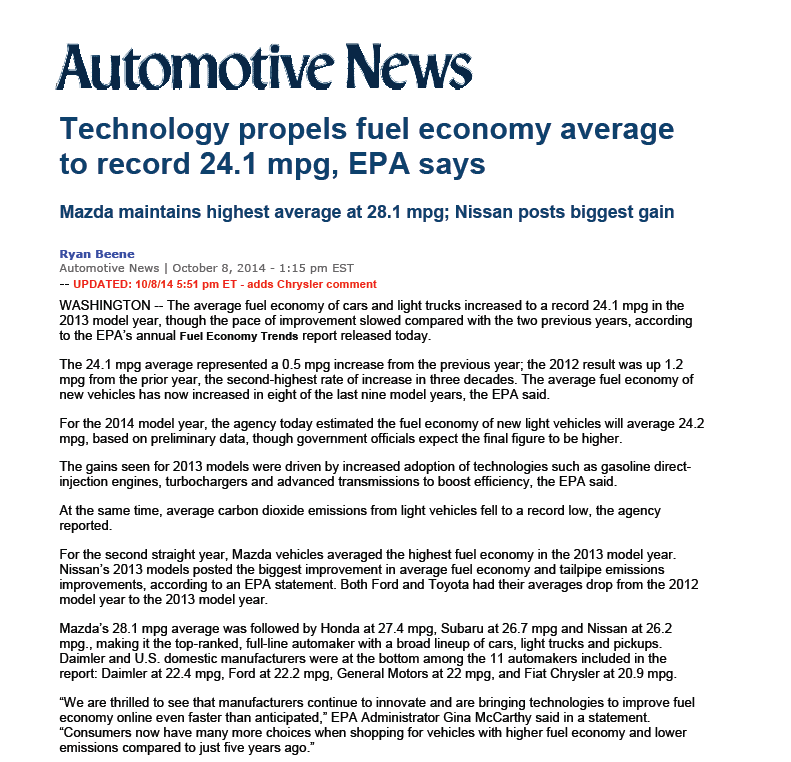WASHINGTON — The average fuel economy of cars and light trucks increased to a record 24.1 mpg in the 2013 model year, though the pace of improvement slowed compared with the two previous years, according to the EPA’s annual Fuel Economy Trends report released today.
The 24.1 mpg average represented a 0.5 mpg increase from the previous year; the 2012 result was up 1.2 mpg from the prior year, the second-highest rate of increase in three decades. The average fuel economy of new vehicles has now increased in eight of the last nine model years, the EPA said.
For the 2014 model year, the agency today estimated the fuel economy of new light vehicles will average 24.2 mpg, based on preliminary data, though government officials expect the final figure to be higher.
The gains seen for 2013 models were driven by increased adoption of technologies such as gasoline direct-injection engines, turbochargers and advanced transmissions to boost efficiency, the EPA said.
At the same time, average carbon dioxide emissions from light vehicles fell to a record low, the agency reported.
For the second straight year, Mazda vehicles averaged the highest fuel economy in the 2013 model year. Nissan’s 2013 models posted the biggest improvement in average fuel economy and tailpipe emissions improvements, according to an EPA statement. Both Ford and Toyota had their averages drop from the 2012 model year to the 2013 model year.
Mazda’s 28.1 mpg average was followed by Honda at 27.4 mpg, Subaru at 26.7 mpg and Nissan at 26.2 mpg., making it the top-ranked, full-line automaker with a broad lineup of cars, light trucks and pickups. Daimler and U.S. domestic manufacturers were at the bottom among the 11 automakers included in the report: Daimler at 22.4 mpg, Ford at 22.2 mpg, General Motors at 22 mpg, and Fiat Chrysler at 20.9 mpg.
“We are thrilled to see that manufacturers continue to innovate and are bringing technologies to improve fuel economy online even faster than anticipated,” EPA Administrator Gina McCarthy said in a statement. “Consumers now have many more choices when shopping for vehicles with higher fuel economy and lower emissions compared to just five years ago.”
Hyundai, Kia
Hyundai and Kia were left out of the EPA’s ranking of the top 11 automakers because of the agency’s ongoing investigation into each brand’s flawed testing data that prompted the companies to lower fuel economy ratings for several models in 2012.
Had they been included, Hyundai would have been No. 1 overall with a 29 mpg average for the 2013 model year, the EPA said, while Kia’s 27.4 mpg average would have put it in a tie with Honda.
The EPA’s annual Fuel Economy Trends report serves as a snapshot of the real-world fuel economy of vehicles sold in the U.S. in a given model year. The report’s fuel economy and carbon dioxide emissions figures reflect adjustments from those used to measure compliance with the EPA’s greenhouse gas regulations, and the National Highway Traffic Safety Administration’s Corporate Average Fuel Economy rules.
In last year’s report, Mazda took the fuel economy crown with an average rating of 27.1 mpg on its 2012 models, followed by Honda at 26.6 mpg and Toyota at 25.6 mpg. U.S. domestic automakers ranked near the bottom in the 2012 model year, with Fiat Chrysler ranking last among the 11 automakers included in the report at 20.1 mpg, Daimler at 21.1 mpg in 10th place, GM at No. 9 with 21.7 mpg and Ford at No. 8 with 22.8 mpg.
Automakers have poured billions into new fuel-saving technologies to meet tougher fuel economy and tailpipe emissions regulations, which work in parallel toward the Obama administration’s plan to require cars and light trucks to average 54.5 mpg by the 2025 model year.
Nissan, in a statement, credited its gains, in part, “to the introduction of three all-new fuel-efficient models for the 2013 model year — Altima, Pathfinder and Sentra.”
Among vehicle segments, SUVs, considered some of the industry’s biggest gas-guzzlers, achieved the greatest improvement by class, the EPA said.
Chrysler Group, noting the report’s findings are preliminary, said in a statement it “is making strides to improve the fuel economy of its vehicles, particularly its light trucks which are in increasingly high demand.”
It cited the recent introduction of the Ram 1500 EcoDiesel — rated at 28 mpg on the highway, or the highest “highway-cycle number” ever recorded on a full-sized pickup — as an example.
Auto, environmental groups weigh in
Automotive trade groups praised the industry’s progress, while noting that the popularity of pickups and SUVs must be considered as the next round of federal fuel economy regulations are considered.
In a statement, the Alliance of Automobile Manufacturers, which represents 12 automakers in the U.S. market, said companies have responded to tougher federal fuel economy rules by offering fuel-saving technologies across their lineups.
The group noted, however, that “the report is also a vivid reminder that the ultimate success of the national program is not predicated on what we produce, but on what consumers choose to buy, especially with today’s lower gas prices.”
Several recent studies show that fuel economy is one of the most powerful factors in consumer car-buying habits. Yet despite the growing availability of hybrids, plug-in hybrids and electric vehicles, sales of advanced powertrain vehicles have remained relatively limited while pickups and SUVs have fueled much of U.S. auto industry growth in 2014.
Overall, U.S. car sales have climbed 1 percent this year, while demand for light trucks, which are generally less fuel efficient, has advanced 10 percent.
“Gas prices and consumer preferences for trucks are some of the many factors that influence overall fleet fuel economy,” said John Bozzella, CEO of Global Automakers, the trade group representing several foreign-owned automakers such as Honda, Hyundai-Kia and Nissan. “We need to be mindful of such items as we begin the midterm review to reassess the feasibility of the 2022-2025 fuel economy and [greenhouse gas] regulations. The EPA’s report will be an important asset as we begin that process.”
The report projects a modest 0.1 mpg improvement in the 2014 model year based on preliminary data, but Luke Tonachel, director of the Clean Vehicles and Fuels Project at the Natural Resources Defense Council, noted in a blog post that the year-to-year figures can be skewed by product rollout plans.
“This is clearly something to watch and consider in the context of potentially larger improvements with model year 2015 vehicles arriving in showrooms now,” Tonachel said. “Multiyear product design cycles can mean that fleet improvements don’t follow the same trajectory year over year.”
Dave Cooke, an analyst with the Union of Concerned Scientists’ Clean Vehicles Program, said automakers’ fuel economy strides are slightly ahead of what regulators had earlier anticipated.
Cooke said, “From our perspective, this is good news. It shows that the manufacturers are on pace to continue to meet these standards, at least out until 2016, which is really the next major milestone.”
| Manufacturer | Adj. Fuel Economy (MPG) | ||
| 2012 | 2013 | 2014 | |
| Mazda | 27.1 | 28.1 | 28.8 |
| Honda | 26.6 | 27.4 | 27.6 |
| Subaru | 25.2 | 26.7 | 27.5 |
| Nissan | 24.1 | 26.2 | 26.8 |
| VW | 25.5 | 25.7 | 26.7 |
| Toyota | 25.6 | 25.1 | 25.8 |
| BMW | 23.7 | 24.5 | 26.0 |
| Daimler | 21.1 | 22.4 | 22.8 |
| Ford | 22.8 | 22.2 | 23.4 |
| GM | 21.7 | 22.0 | 22.0 |
| Chrysler-Fiat | 20.1 | 20.9 | 21.1 |
| All | 23.6 | 24.1 | 24.2 |
| Source: EPA | |||
Original Source: Automotive News
Click to View PDF:


